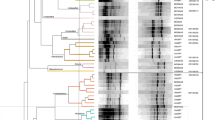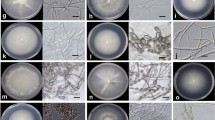Abstract
Phelipanche ramosa is a major root-holoparasitic damaging weed characterized by a broad host range, including numerous Fabaceae species. In France, the agricultural threat posed by P. ramosa has increased over two decades due to the appearance of a genetically differentiated pathovar presenting a clear host specificity for oilseed rape. The new pathovar has led to a massive expansion of P. ramosa in oilseed rape fields. The germination rate of P. ramosa seeds is currently known to vary among P. ramosa pathovars and host species. However, only a few studies have investigated whether phylogenetic relatedness among potential host species is a predictor of the ability of these species to induce the seed germination of parasitic weeds by testing for phylogenetic signal. We focused on a set of 12 Fabaceae species and we assessed the rate of induction of seed germination by these species for two pathovars based on in vitro co-cultivation experiments. All Fabaceae species tested induced the germination of P. ramosa seeds. The germination rate of P. ramosa seeds varied between Fabaceae species and tribes studied, while pathovars appeared non-influential. Considering oilseed rape as a reference species, we also highlighted a significant phylogenetic signal. Phylogenetically related species therefore showed more similar rates of induction of seed germination than species drawn at random from a phylogenetic tree. In in vitro conditions, only Lotus corniculatus induced a significantly higher germination rate than oilseed rape, and could potentially be used as a catch crop after confirmation of these results under field conditions.

Similar content being viewed by others
References
Auger B, Pouvreau JB, Pouponneau K, Yoneyama K, Montiel G, Le Bizec B, Yoneyama K, Delavault P, Delourme R, Simier P (2012) Germination stimulants of Phelipanche ramosa in the rhizosphere of Brassica napus are derived from the glucosinolate pathway. Mol Plant-Microb Interact 25:993–1004
Benharrat H, Boulet C, Theodet C, Thalouarn P (2005) Virulence diversity among branched broomrape (O. ramosa L.) populations in France. Agron Sustain Dev 25:123–128
Blomberg SP, Garland T (2002) Tempo and mode in evolution: phylogenetic inertia, adaptation and comparative methods. J Evol Biol 15:899–910
Blomberg SP, Garland T, Ives AR (2003) Testing for phylogenetic signal in comparative data: behavioral traits are more labile. Evol 57:717–745
Boulet C, Labrousse P, Arnaud MC, Zehhar N, Fer A (2001) Weed species present various responses to Orobanche ramosa L. attack. In: Fer A, Thalouarn P, Joel DM, Musselman LJ, Parker C, Verkleij JAC (eds) Proc. 7th Int. parasitic weed symposium, Nantes, pp 228–231
Boulet C, Pineault D, Benharrat H, Simier P, Delavault P (2007) Adventices du colza et orobanche rameuse. In: AFPP (ed) Vingtième conférence du COLUMA: Journées internationales sur la lutte contre les mauvaises herbes, Fontenay-Le- Compte, France, pp 326–345
Brault M, Betsou F, Jeune B, Tuquet C, Salle G (2007) Variability of Orobanche ramosa populations in France as revealed by cross infestations and molecular markers. Environ Exp Bot 67:271–280
Buschmann H, Gonsior G, Sauerborn J (2005) Pathogeneticity of branched broomrape (Orobanche ramosa) populations on tobacco cultivars. Plant Pathol 54:650–656
Cacho NI, Kliebenstein DJ, Strauss SY (2015) Macroevolutionary patterns of glucosinolate defense and test of defense-escalation and resource availability hypotheses. New Phytol 208:915–927
Dangui R, Tamhankar S, Choudhary RK, Rao S (2016) Molecular phylogenetics and systematics of Trigonella L. (Fabaceae) based on nuclear ribosomal ITS and chloroplast trnL intron sequences. Genet Resour Crop Evol 63:79–96
Edgar RC (2004) MUSCLE: multiple sequence alignment with high accuracy and high throughput. Nucl Acid Res 32:1792–1797
Felsenstein J (1981) Evolutionary trees from DNA sequences: a maximum likelihood approach. J Mol Evol 17:368–376
Fernández-Aparicio M, Flores F, Rubiales D (2009) Recognition of root exudates by seeds of broomrape (Orobanche and Phelipanche) species. Ann Bot 103:423–431
Fernández-Aparicio M, Yoneyama K, Rubiales D (2011) The role of strigolactones in host specificity of Orobanche and Phelipanche seed germination. Seed Sci Res 21:55–61
Fernández-Aparicio M, Reboud X, Gibot-Leclerc S (2016) Broomrape weeds. Underground mechanisms of parasitism and associated strategies for their control: a review. Front Plant Sci 7:135
Gauthier M, Véronési C, El-Halmouch Y, Leflon M, Jestin C, Labalette F, Simier P, Delourme R, Delavault P (2012) Characterisation of resistance to branched broomrape, Phelipanche ramosa, in winter oilseed rape. Crop Prot 42:56–63
Gibot-Leclerc S, Brault M, Pinochet X, Salle G (2003) Potential role of winter rape weeds in the extension of broomrape in Poitou-Charentes. C R Biol 326:645–658
Gibot-Leclerc S, Salle G, Reboud X, Moreau D (2012) What are the traits to Phelipanche ramosa (L.) Pomel that contribute to the success of its biological cycle on its host Brassica napus L.? Flora 207:512–521
Gibot-Leclerc S, Dessaint F, Reibel C, Le Corre V (2013) Phelipanche ramosa (L.) Pomel populations differ in life-history and infection response to hosts. Flora 208:247–252
Gibot-Leclerc S, Perronne R, Dessaint F, Reibel C, Le Corre V (2016) Assessment of phylogenetic signal in the germination of Phelipanche ramosa on Brassicaceae hosts. Weed Res 56:452–461
Gilbert GS, Magarey R, Suiter K, Webb CO (2012) Evolutionary tools for phytosanitary risk analysis: phylogenetic signal as a predictor of host range of plant pests and pathogens. Evol Appl 5:869–878
Gilbert GS, Briggs HM, Magarey R (2015) The impact of plant enemies shows a phylogenetic signal. PloS ONE 10:e0123758
Hardy OJ (2008) Testing the spatial phylogenetic structure of local communities: statistical performances of different null models and test statistics on a locally neutral community. J Ecol 96:914–926
Hardy OJ, Pavoine S (2012) Assessing phylogenetic signal with measurement error: a comparison of Mantel tests., Blomberg et al.’s K, and phylogenetic distograms. Evol 66:2614–2621
Ives AR, Midford PE, Garland T (2007) Within-species variation and measurement error in phylogenetic comparative methods. Syst Biol 56:252–270
Joel DM, Gressel J, Musselman LJ (2013) Root parasitic Orobanchaceae: parasitic mechanisms and control strategies. Springer, Heidelberg
Kogan M (1994) Orobanche in Chile: a research report. In: Pieterse AH, Verkleij JAC, ter Borg SJ (eds) Biology and Management of Orobanche. Proc. 3rd Int. Workshop on Orobanche and related Striga Res., Royal Tropical Institute, Amsterdam, 599–603
Labrada R (1994) Occurrence and control of Orobanche ramosa L. in Cuba. In: Pieterse AH, Verkleij JAC, ter Borg SJ (eds) Biology and Management of Orobanche. Proc. 3rd Int. Workshop on Orobanche and related Striga Res., Royal Tropical Institute, Amsterdam, pp 604–610
Lavin M, Herendeen PS, Wojciechowski MF (2005) Evolutionary rates analysis of leguminosae implicates a rapid diversification of lineages during the Tertiary. Syst Biol 54:575–594
Le Corre V, Reibel C, Gibot-Leclerc S (2014) Development of microsatellite markers in branched broomrape Phelipanche ramosa L. (Pomel) and evidence for host-associated genetic divergence. Int J Mol Sci 15:994–1002
Losos J (2008) Phylogenetic niche conservatism, phylogenetic signal and the relationship between phylogenetic relatedness and ecological similarity among species. Ecol Lett 11:995–1007
Mangnus EM, Dommerhholt FJ, De Jong RLP, Zwanenburg B (1992) Improved synthesis of strigol analogue GR24 and evaluation of the biological activity of its diastereomers. J Agric Food Chem 40:1230–1235
Moore RP (1973) Tetrazolium staining for assessing seed quality. In: Heydecker W (ed) Seed ecology. Butterworths, London, pp 347–366
Parker C, Riches P (1993) Parasitic weeds of the world: biology and control. CAB International, Wallingford
Pavoine S, Ricotta C (2013) Testing for phylogenetic signal in biological traits: the ubiquity of cross-product statistics. Evol 67:828–840
Rubiales D, Fernández-Aparicio M (2012) Innovations in parasitic weeds management in legume crops. A review. Agron Sustain Dev 32:433–449
Rubiales D, Fernández-Aparicio M, Wegmann K, Joel DM (2009) Revisiting strategies for reducing the seedbank of Orobanche and Phelipanche spp. Weed Res 49:23–33
Sillero JC, Moreno MT, Rubiales D (2005) Sources of resistance to crenate broomrape among species of Vicia. Plant Dis 89:23–27
Tamura K, Stecher S, Peterson D, Filipski A, Kumar S (2013) MEGA6: Molecular evolutionary genetics analysis version 6. Mol Biol Evol 30:2725–2729
Wang C, Liu Y, Li SS, Han GZ (2015) Insights into the origin and evolution of the plant hormone signaling machinery. Plant Physiol 167:872–886
Wojciechowski MF (2003) Reconstructing the phylogeny of legumes (Leguminosae): an early 21st century perspective. In: Klitgaard BB, Bruneau A (eds). Adv Legume Syst 10:5–35
Wojciechowski MF, Lavin M, Sanderson MJ (2004) A phylogeny of legumes (Leguminosae) based on analysis of the plastid matK gene resolves many well-supported subclades within the family. Am J Bot 91:1846–1862
Xie X. Yoneyama K, Yoneyama K (2010) The strigolactone story. Annu Rev Phytopathol 48:93–117
Yoneyama K, Xie X, Sekimoto H, Takeuchi Y, Ogasawara S, Akiyama K, Hayashi H, Yoneyama K (2008) Strigolactones, host recognition signals for root parasitic plants and arbuscular mycorrhizal fungi, from Fabaceae plants. New Phytol 179:484–494
Zehhar N, Labrousse P, Arnaud MC, Boulet C, Bouya D, Fer A (2003) Study of resistance to Orobanche ramosa in host (oilseed rape and carrot) and non-host (maize) plants. Eur J Plant Pathol 109:75–82
Acknowledgements
This project was financially supported by the CASDAR project PheraFAB (AAP No. C-2013-07).
Author information
Authors and Affiliations
Corresponding author
Ethics declarations
Conflict of interest
The authors declare that they have no conflict of interest.
Rights and permissions
About this article
Cite this article
Perronne, R., Gibot-Leclerc, S., Dessaint, F. et al. Is induction ability of seed germination of Phelipanche ramosa phylogenetically structured among hosts? A case study on Fabaceae species. Genetica 145, 481–489 (2017). https://doi.org/10.1007/s10709-017-9990-x
Received:
Accepted:
Published:
Issue Date:
DOI: https://doi.org/10.1007/s10709-017-9990-x




